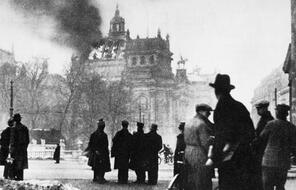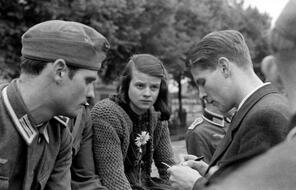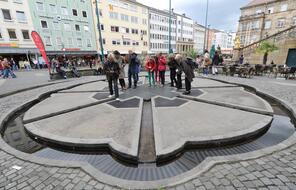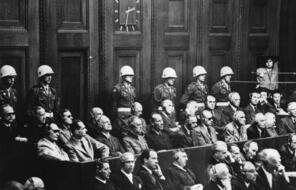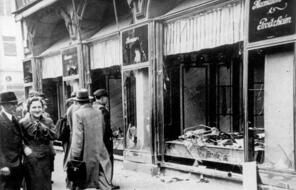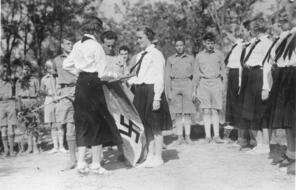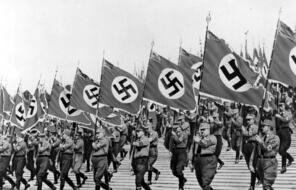What Did the World Know?
Subject
- History
Language
English — USUpdated
What did the rest of the world know about the Nazis’ policies of annihilation during World War II and the terror and mass murder spreading across Europe as a result?
By summer 1941, British intelligence agents were listening in on classified German radio transmissions that described systematic mass murders in Lithuania, Latvia, and later Ukraine. News also came from the Soviets. On August 14, 1941, British Prime Minister Winston Churchill summarized the news in a broadcast to the public:
As [Hitler’s] armies advance, whole districts are being exterminated. Scores of thousands, literally scores of thousands of executions in cold blood, are being perpetrated by the German police troops upon the Russian patriots who defend their native soil. . . . And this is but the beginning. Famine and pestilence have yet to follow in the bloody ruts of Hitler's tanks.
We are in the presence of a crime without a name. 1
Additional confirmation came in spring 1942, when American journalists stranded in Germany when the United States entered the war were exchanged for Axis nationals stranded in the United States. Historian Deborah Lipstadt describes the articles these journalists wrote after they returned home:
Glen Stadler, UP [United Press] correspondent in Germany, described what had happened to Jews in Latvia, Estonia, and Lithuania as an “open hunt.” Some of the reporters estimated that more than 400,000 had already been killed by Hitler’s “new order,” including “upward of 100,000 [Jews who] met death in the Baltic states alone, and more than that . . . have been executed in Western Russia.”
Joseph Grigg, also of the UP, reported: “One of the biggest slaughters occurred in Latvia in the summer of 1941 when, responsible Nazi sources admitted, 56,000 men, women and children were killed by S.S. troops and Latvian irregulars.” 2
News also filtered out of occupied Europe through government channels. Following Poland’s defeat by Germany, Polish leaders had established a temporary “government in exile” in Britain. In June 1942, they received a secret report from occupied Poland confirming that the Germans were murdering Jews throughout the country. Newspapers around the world carried the story.
The London Times reported:
MASSACRE OF JEWS—OVER 1,000,000 DEAD SINCE THE WAR BEGAN
The Montreal Daily Star stated:
“NAZI SLAUGHTERHOUSE”—GERMANS MASSACRE MILLION JEWS IN EXTERMINATION DRIVE
The Los Angeles Times wrote:
NAZIS KILL MILLION JEWS, SAYS SURVEY
The New York Journal American declared:
JEWS LIST THEIR DEAD AT A MILLION 3
Recalling atrocity stories during World War I that later proved to be false, American journalists tended to be cautious about claims of mass murder. So even though they reported the news, their editors rarely featured those stories on the front page and were careful not to emphasize claims of atrocities. Nevertheless, on December 13, 1942, Edward R. Murrow of the CBS radio network bluntly reported, “What is happening is this. Millions of human beings, most of them Jews, are being gathered up with ruthless efficiency and murdered. The phrase ‘concentration camps’ is obsolete, as out of date as economic sanctions or non-recognition. It is now possible only to speak of extermination camps.” 4
Four days later, the governments of the United States, Britain, and the Soviet Union issued a joint declaration that “the German authorities, not content with denying to persons of the Jewish race in all the territories over which their barbarous rule has been extended the most elementary human rights, are now carrying into effect Hitler’s oft-repeated intention to exterminate the Jewish people of Europe.” The declaration stated, in part:
Jews are being transported in conditions of appalling horror and brutality to Eastern Europe. In Poland, which has been made the principal Nazi slaughterhouse, the ghettos established by the German invaders are being systematically emptied of all Jews except a few highly skilled workers required for war industries. None of those taken away are ever heard of again. The able-bodied are slowly worked to death in labor camps. The infirm are left to die of exposure and starvation or are deliberately massacred in mass executions. The number of victims of these bloody cruelties is reckoned in many hundreds of thousands of entirely innocent men, women, and children. 5
The Allies believed that the best way to help the Jews was to win the war. They warned Nazi leaders that they would be held responsible for their crimes once Germany was defeated.
Connection Questions
- What information was available in Britain and the United States about massacres in the Baltic states and the USSR in the early 1940s? What information was available about the concentration camps and death camps in 1942?
- Why did Churchill call the mass murders of 1941 “a crime without a name”? Why might it make a difference to have a name for a crime?
- Why would articles about mass murder have failed to make the front pages of newspapers around the world? What forces might shape or determine the selection of the stories that newspapers feature today?
- 1“Prime Minister Winston Churchill’s Broadcast to the World,” August 24, 1941, British Library of Information, available from Ibiblio, accessed June 19, 2016.
- 2Deborah E. Lipstadt, Beyond Belief: The American Press and the Coming of the Holocaust, 1933–1945 (New York: Simon & Schuster, 1993), 159–60.
- 3Quoted in ibid., 163–65.
- 4Edward Bliss, Jr., ed., In Search of Light: The Broadcasts of Edward R. Murrow, 1938–1961 (New York: Alfred A. Knopf, 1967), 56–57.
- 5"Declaration Regarding German Atrocities Against Jews in German Occupied Countries,” issued Dec. 17, 1942, The United Nations Review III, no. 1 (1943): 1.
How to Cite This Reading
Facing History & Ourselves, “What Did the World Know?”, last updated August 2, 2016.


